Social Media's Impact on Organizational Communication and Stakeholders
VerifiedAdded on 2021/06/15
|14
|3766
|828
Report
AI Summary
This business research proposal examines the impact of social media on organizational communication, focusing on its effects on various stakeholders, including customers, employees, and shareholders. The research explores the strengths and weaknesses of using social media for communication, brand promotion, and customer engagement. It reviews existing literature on the topic, identifying gaps and opportunities for further research. The study employs a detailed methodology, including primary and secondary research, to analyze the relationship between social media and organizational communication culture. The proposal outlines research questions, design, and data collection methods, aiming to understand how social media transforms information flow, decision-making, transparency, and employee retention within organizations. The research intends to provide insights into the strategic use of social media for effective communication and its implications for organizational success.
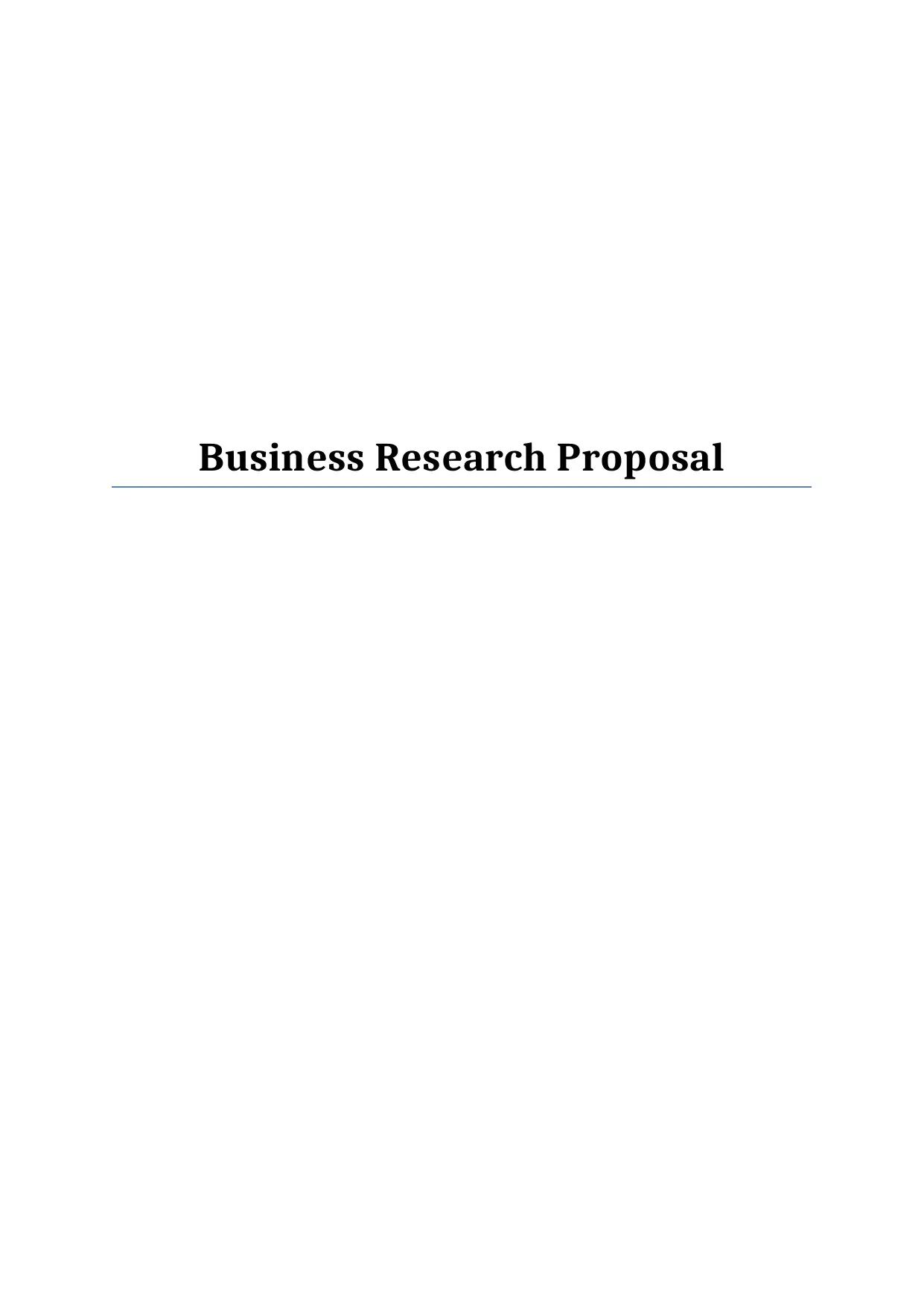
Business Research Proposal
Paraphrase This Document
Need a fresh take? Get an instant paraphrase of this document with our AI Paraphraser
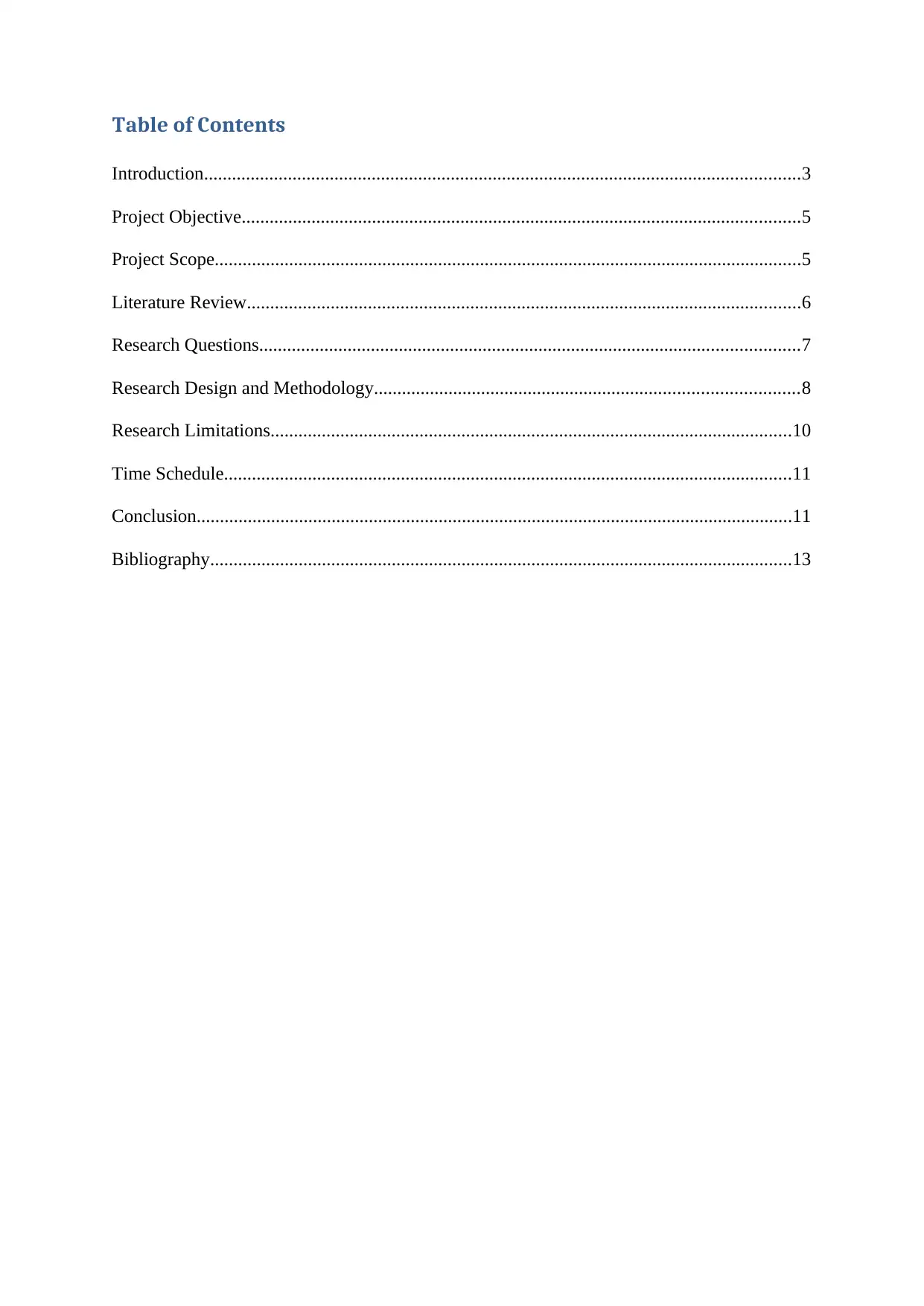
Table of Contents
Introduction................................................................................................................................3
Project Objective........................................................................................................................5
Project Scope..............................................................................................................................5
Literature Review.......................................................................................................................6
Research Questions....................................................................................................................7
Research Design and Methodology...........................................................................................8
Research Limitations................................................................................................................10
Time Schedule..........................................................................................................................11
Conclusion................................................................................................................................11
Bibliography.............................................................................................................................13
Introduction................................................................................................................................3
Project Objective........................................................................................................................5
Project Scope..............................................................................................................................5
Literature Review.......................................................................................................................6
Research Questions....................................................................................................................7
Research Design and Methodology...........................................................................................8
Research Limitations................................................................................................................10
Time Schedule..........................................................................................................................11
Conclusion................................................................................................................................11
Bibliography.............................................................................................................................13
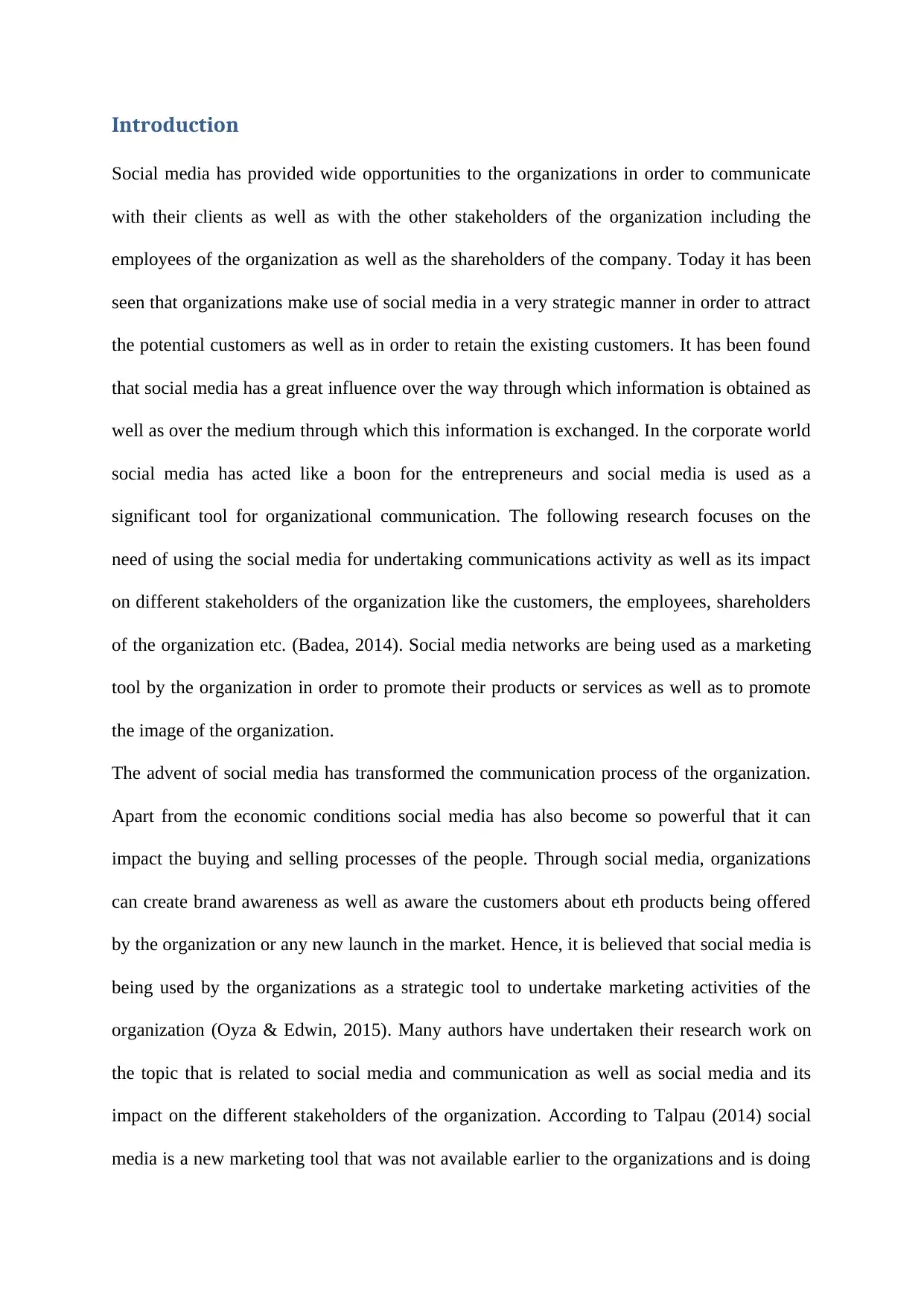
Introduction
Social media has provided wide opportunities to the organizations in order to communicate
with their clients as well as with the other stakeholders of the organization including the
employees of the organization as well as the shareholders of the company. Today it has been
seen that organizations make use of social media in a very strategic manner in order to attract
the potential customers as well as in order to retain the existing customers. It has been found
that social media has a great influence over the way through which information is obtained as
well as over the medium through which this information is exchanged. In the corporate world
social media has acted like a boon for the entrepreneurs and social media is used as a
significant tool for organizational communication. The following research focuses on the
need of using the social media for undertaking communications activity as well as its impact
on different stakeholders of the organization like the customers, the employees, shareholders
of the organization etc. (Badea, 2014). Social media networks are being used as a marketing
tool by the organization in order to promote their products or services as well as to promote
the image of the organization.
The advent of social media has transformed the communication process of the organization.
Apart from the economic conditions social media has also become so powerful that it can
impact the buying and selling processes of the people. Through social media, organizations
can create brand awareness as well as aware the customers about eth products being offered
by the organization or any new launch in the market. Hence, it is believed that social media is
being used by the organizations as a strategic tool to undertake marketing activities of the
organization (Oyza & Edwin, 2015). Many authors have undertaken their research work on
the topic that is related to social media and communication as well as social media and its
impact on the different stakeholders of the organization. According to Talpau (2014) social
media is a new marketing tool that was not available earlier to the organizations and is doing
Social media has provided wide opportunities to the organizations in order to communicate
with their clients as well as with the other stakeholders of the organization including the
employees of the organization as well as the shareholders of the company. Today it has been
seen that organizations make use of social media in a very strategic manner in order to attract
the potential customers as well as in order to retain the existing customers. It has been found
that social media has a great influence over the way through which information is obtained as
well as over the medium through which this information is exchanged. In the corporate world
social media has acted like a boon for the entrepreneurs and social media is used as a
significant tool for organizational communication. The following research focuses on the
need of using the social media for undertaking communications activity as well as its impact
on different stakeholders of the organization like the customers, the employees, shareholders
of the organization etc. (Badea, 2014). Social media networks are being used as a marketing
tool by the organization in order to promote their products or services as well as to promote
the image of the organization.
The advent of social media has transformed the communication process of the organization.
Apart from the economic conditions social media has also become so powerful that it can
impact the buying and selling processes of the people. Through social media, organizations
can create brand awareness as well as aware the customers about eth products being offered
by the organization or any new launch in the market. Hence, it is believed that social media is
being used by the organizations as a strategic tool to undertake marketing activities of the
organization (Oyza & Edwin, 2015). Many authors have undertaken their research work on
the topic that is related to social media and communication as well as social media and its
impact on the different stakeholders of the organization. According to Talpau (2014) social
media is a new marketing tool that was not available earlier to the organizations and is doing
⊘ This is a preview!⊘
Do you want full access?
Subscribe today to unlock all pages.

Trusted by 1+ million students worldwide
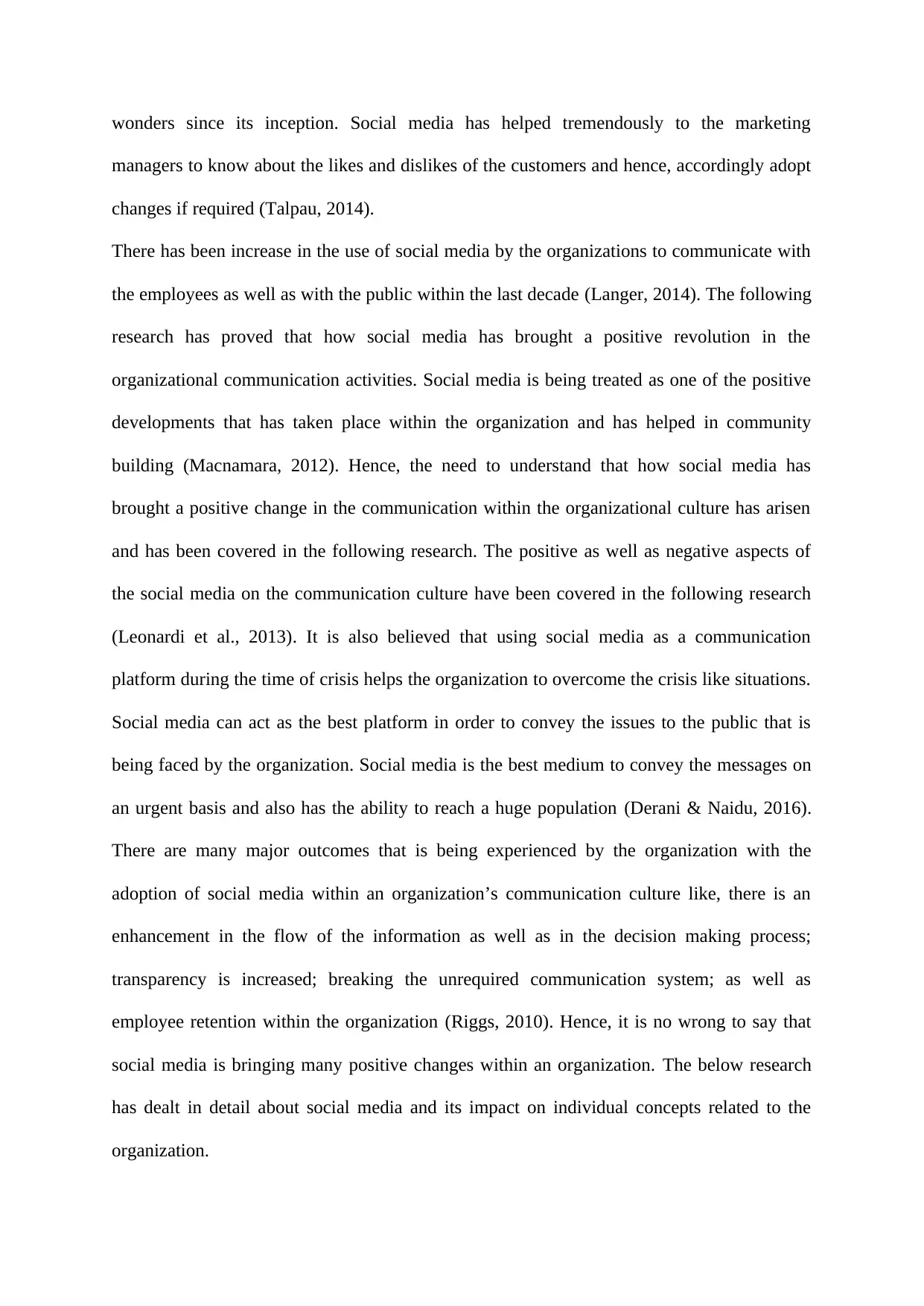
wonders since its inception. Social media has helped tremendously to the marketing
managers to know about the likes and dislikes of the customers and hence, accordingly adopt
changes if required (Talpau, 2014).
There has been increase in the use of social media by the organizations to communicate with
the employees as well as with the public within the last decade (Langer, 2014). The following
research has proved that how social media has brought a positive revolution in the
organizational communication activities. Social media is being treated as one of the positive
developments that has taken place within the organization and has helped in community
building (Macnamara, 2012). Hence, the need to understand that how social media has
brought a positive change in the communication within the organizational culture has arisen
and has been covered in the following research. The positive as well as negative aspects of
the social media on the communication culture have been covered in the following research
(Leonardi et al., 2013). It is also believed that using social media as a communication
platform during the time of crisis helps the organization to overcome the crisis like situations.
Social media can act as the best platform in order to convey the issues to the public that is
being faced by the organization. Social media is the best medium to convey the messages on
an urgent basis and also has the ability to reach a huge population (Derani & Naidu, 2016).
There are many major outcomes that is being experienced by the organization with the
adoption of social media within an organization’s communication culture like, there is an
enhancement in the flow of the information as well as in the decision making process;
transparency is increased; breaking the unrequired communication system; as well as
employee retention within the organization (Riggs, 2010). Hence, it is no wrong to say that
social media is bringing many positive changes within an organization. The below research
has dealt in detail about social media and its impact on individual concepts related to the
organization.
managers to know about the likes and dislikes of the customers and hence, accordingly adopt
changes if required (Talpau, 2014).
There has been increase in the use of social media by the organizations to communicate with
the employees as well as with the public within the last decade (Langer, 2014). The following
research has proved that how social media has brought a positive revolution in the
organizational communication activities. Social media is being treated as one of the positive
developments that has taken place within the organization and has helped in community
building (Macnamara, 2012). Hence, the need to understand that how social media has
brought a positive change in the communication within the organizational culture has arisen
and has been covered in the following research. The positive as well as negative aspects of
the social media on the communication culture have been covered in the following research
(Leonardi et al., 2013). It is also believed that using social media as a communication
platform during the time of crisis helps the organization to overcome the crisis like situations.
Social media can act as the best platform in order to convey the issues to the public that is
being faced by the organization. Social media is the best medium to convey the messages on
an urgent basis and also has the ability to reach a huge population (Derani & Naidu, 2016).
There are many major outcomes that is being experienced by the organization with the
adoption of social media within an organization’s communication culture like, there is an
enhancement in the flow of the information as well as in the decision making process;
transparency is increased; breaking the unrequired communication system; as well as
employee retention within the organization (Riggs, 2010). Hence, it is no wrong to say that
social media is bringing many positive changes within an organization. The below research
has dealt in detail about social media and its impact on individual concepts related to the
organization.
Paraphrase This Document
Need a fresh take? Get an instant paraphrase of this document with our AI Paraphraser

Project Objective
The main objective of this research is to find out about the impact of social media on the
communication culture of an organization as well as on the different stakeholders of the
organization. This research aims to find out about the strengths as well as weaknesses of the
use of social media in the communication culture of the organization. Social media provides
strengths like brand promotion in the market, product promotion in the market, engagement
of the employees, improved communication structure, etc. Weaknesses of the social media
includes negative exposures in the market, security related issues, being indulged in some
legal violations, etc. (SHRM, 2018).
Project Scope
The scope of the project revolves around the planning related to the research and determining
the goals of the research as well as the steps adopted to achieve these objectives (Gotto,
2013). The ultimate scope of the project is to find out about the relationship between the use
of social media and its impact on the communication culture of the organization. The project
also extends to discuss in detail about the advent of social media and its adoption in the
organizations and how after that the image of the organizations has changed including the
change in their communication pattern. The project aims to find the level of engagement of
social media within an organization and how one activity is linked with social media in order
to gain positive results. For this purpose primary as well as secondary research has been
conducted that will help to analyse and evaluate the relationship between social media and
communication culture within an organization.
The main objective of this research is to find out about the impact of social media on the
communication culture of an organization as well as on the different stakeholders of the
organization. This research aims to find out about the strengths as well as weaknesses of the
use of social media in the communication culture of the organization. Social media provides
strengths like brand promotion in the market, product promotion in the market, engagement
of the employees, improved communication structure, etc. Weaknesses of the social media
includes negative exposures in the market, security related issues, being indulged in some
legal violations, etc. (SHRM, 2018).
Project Scope
The scope of the project revolves around the planning related to the research and determining
the goals of the research as well as the steps adopted to achieve these objectives (Gotto,
2013). The ultimate scope of the project is to find out about the relationship between the use
of social media and its impact on the communication culture of the organization. The project
also extends to discuss in detail about the advent of social media and its adoption in the
organizations and how after that the image of the organizations has changed including the
change in their communication pattern. The project aims to find the level of engagement of
social media within an organization and how one activity is linked with social media in order
to gain positive results. For this purpose primary as well as secondary research has been
conducted that will help to analyse and evaluate the relationship between social media and
communication culture within an organization.
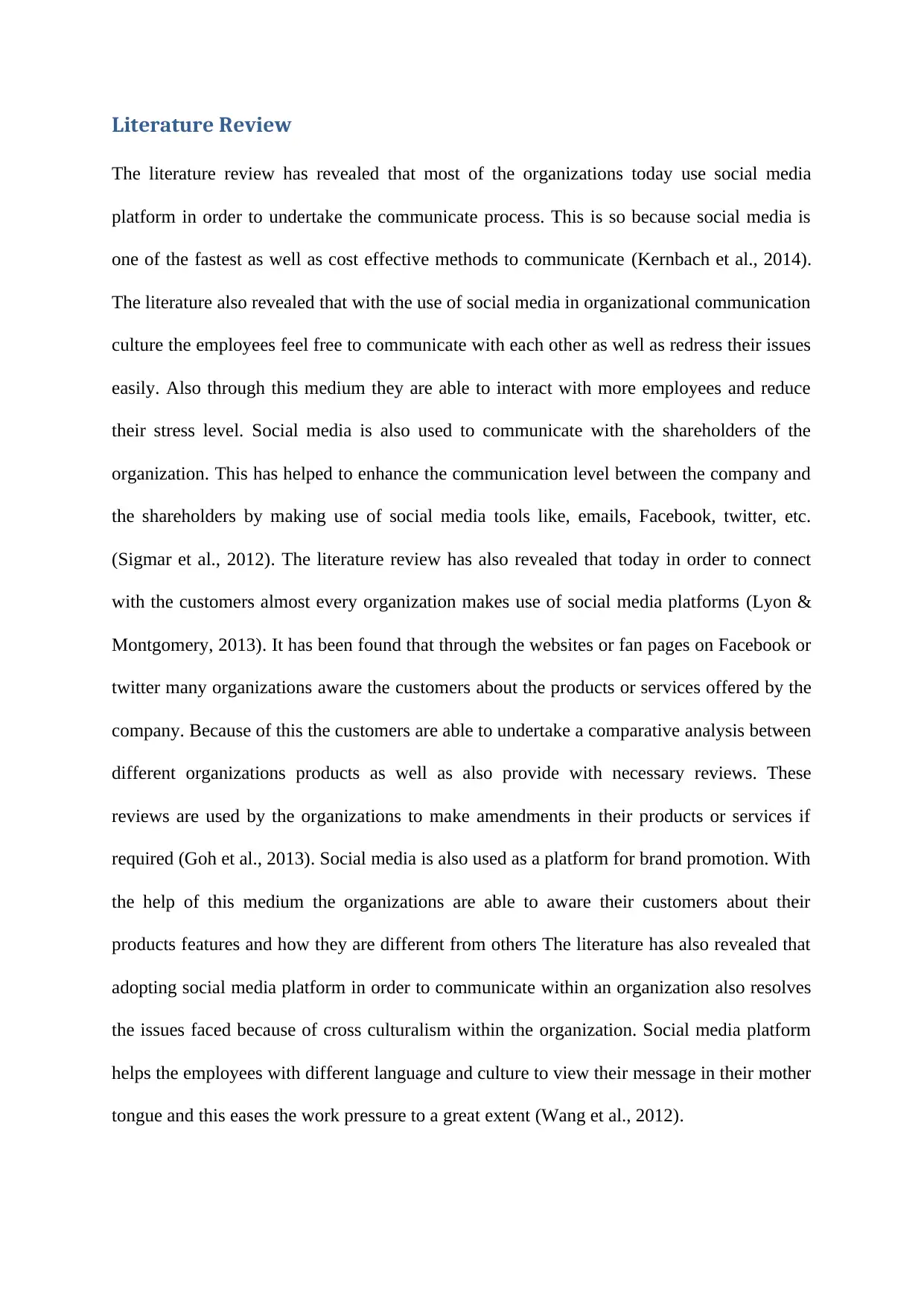
Literature Review
The literature review has revealed that most of the organizations today use social media
platform in order to undertake the communicate process. This is so because social media is
one of the fastest as well as cost effective methods to communicate (Kernbach et al., 2014).
The literature also revealed that with the use of social media in organizational communication
culture the employees feel free to communicate with each other as well as redress their issues
easily. Also through this medium they are able to interact with more employees and reduce
their stress level. Social media is also used to communicate with the shareholders of the
organization. This has helped to enhance the communication level between the company and
the shareholders by making use of social media tools like, emails, Facebook, twitter, etc.
(Sigmar et al., 2012). The literature review has also revealed that today in order to connect
with the customers almost every organization makes use of social media platforms (Lyon &
Montgomery, 2013). It has been found that through the websites or fan pages on Facebook or
twitter many organizations aware the customers about the products or services offered by the
company. Because of this the customers are able to undertake a comparative analysis between
different organizations products as well as also provide with necessary reviews. These
reviews are used by the organizations to make amendments in their products or services if
required (Goh et al., 2013). Social media is also used as a platform for brand promotion. With
the help of this medium the organizations are able to aware their customers about their
products features and how they are different from others The literature has also revealed that
adopting social media platform in order to communicate within an organization also resolves
the issues faced because of cross culturalism within the organization. Social media platform
helps the employees with different language and culture to view their message in their mother
tongue and this eases the work pressure to a great extent (Wang et al., 2012).
The literature review has revealed that most of the organizations today use social media
platform in order to undertake the communicate process. This is so because social media is
one of the fastest as well as cost effective methods to communicate (Kernbach et al., 2014).
The literature also revealed that with the use of social media in organizational communication
culture the employees feel free to communicate with each other as well as redress their issues
easily. Also through this medium they are able to interact with more employees and reduce
their stress level. Social media is also used to communicate with the shareholders of the
organization. This has helped to enhance the communication level between the company and
the shareholders by making use of social media tools like, emails, Facebook, twitter, etc.
(Sigmar et al., 2012). The literature review has also revealed that today in order to connect
with the customers almost every organization makes use of social media platforms (Lyon &
Montgomery, 2013). It has been found that through the websites or fan pages on Facebook or
twitter many organizations aware the customers about the products or services offered by the
company. Because of this the customers are able to undertake a comparative analysis between
different organizations products as well as also provide with necessary reviews. These
reviews are used by the organizations to make amendments in their products or services if
required (Goh et al., 2013). Social media is also used as a platform for brand promotion. With
the help of this medium the organizations are able to aware their customers about their
products features and how they are different from others The literature has also revealed that
adopting social media platform in order to communicate within an organization also resolves
the issues faced because of cross culturalism within the organization. Social media platform
helps the employees with different language and culture to view their message in their mother
tongue and this eases the work pressure to a great extent (Wang et al., 2012).
⊘ This is a preview!⊘
Do you want full access?
Subscribe today to unlock all pages.

Trusted by 1+ million students worldwide

Literature Gap and Opportunities
The literature review has also discussed about the literature gap which reveals that as the
organizations have started using social media platform for communication purpose very
recently not much research work was available on the online sources on the same topic.
Another gap was that very limited material is available related to the advantages as well as
disadvantages of the use of social media for communication purpose by the organization.
Many researches have been undertaken related to communication within organization and it’s
important but none have been successful in relating it with the use of social media. Hence,
this literature provides with an opportunity to future researchers. This is so because this
literature has majorly revolved around use of social media by organizations to communicate
with different stakeholders of the company and its impact on them. It has also discussed
about the impact of use of social media and its impact on the organizational communication
culture as well as on the most important stakeholder of the organization that is the customers
of the company.
Research Questions
Primary Research Question: The primary research question is as follows:
What is the impact of use of social media on the communication culture of the
organization?
Secondary Research Questions: The secondary research questions are as follows:
What is the impact of use of social media on the employees as well as the
shareholders of the organization?
What is the impact of use of social media on customers
What are strengths and weaknesses of the use of social media within an organizational
culture?
The literature review has also discussed about the literature gap which reveals that as the
organizations have started using social media platform for communication purpose very
recently not much research work was available on the online sources on the same topic.
Another gap was that very limited material is available related to the advantages as well as
disadvantages of the use of social media for communication purpose by the organization.
Many researches have been undertaken related to communication within organization and it’s
important but none have been successful in relating it with the use of social media. Hence,
this literature provides with an opportunity to future researchers. This is so because this
literature has majorly revolved around use of social media by organizations to communicate
with different stakeholders of the company and its impact on them. It has also discussed
about the impact of use of social media and its impact on the organizational communication
culture as well as on the most important stakeholder of the organization that is the customers
of the company.
Research Questions
Primary Research Question: The primary research question is as follows:
What is the impact of use of social media on the communication culture of the
organization?
Secondary Research Questions: The secondary research questions are as follows:
What is the impact of use of social media on the employees as well as the
shareholders of the organization?
What is the impact of use of social media on customers
What are strengths and weaknesses of the use of social media within an organizational
culture?
Paraphrase This Document
Need a fresh take? Get an instant paraphrase of this document with our AI Paraphraser
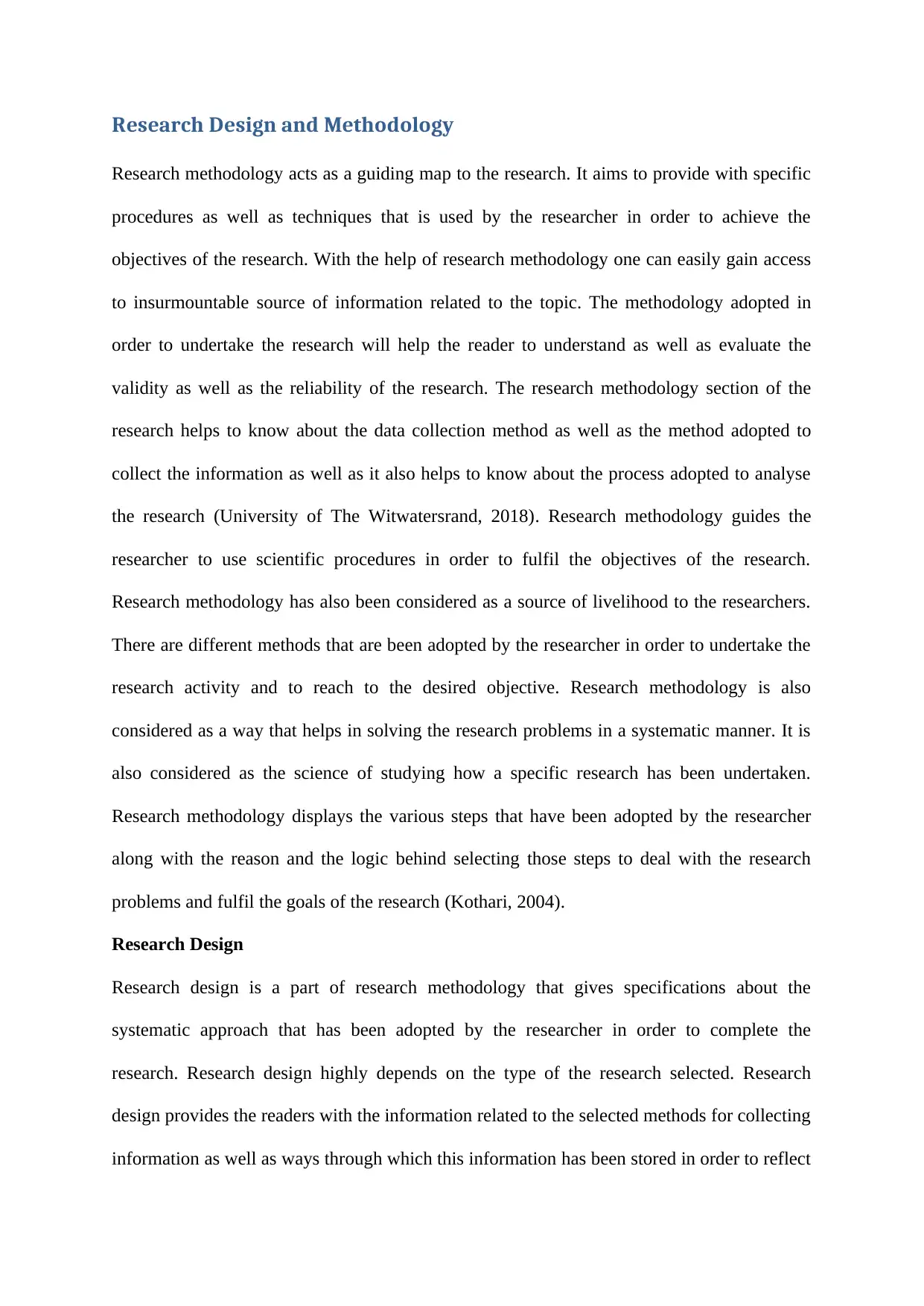
Research Design and Methodology
Research methodology acts as a guiding map to the research. It aims to provide with specific
procedures as well as techniques that is used by the researcher in order to achieve the
objectives of the research. With the help of research methodology one can easily gain access
to insurmountable source of information related to the topic. The methodology adopted in
order to undertake the research will help the reader to understand as well as evaluate the
validity as well as the reliability of the research. The research methodology section of the
research helps to know about the data collection method as well as the method adopted to
collect the information as well as it also helps to know about the process adopted to analyse
the research (University of The Witwatersrand, 2018). Research methodology guides the
researcher to use scientific procedures in order to fulfil the objectives of the research.
Research methodology has also been considered as a source of livelihood to the researchers.
There are different methods that are been adopted by the researcher in order to undertake the
research activity and to reach to the desired objective. Research methodology is also
considered as a way that helps in solving the research problems in a systematic manner. It is
also considered as the science of studying how a specific research has been undertaken.
Research methodology displays the various steps that have been adopted by the researcher
along with the reason and the logic behind selecting those steps to deal with the research
problems and fulfil the goals of the research (Kothari, 2004).
Research Design
Research design is a part of research methodology that gives specifications about the
systematic approach that has been adopted by the researcher in order to complete the
research. Research design highly depends on the type of the research selected. Research
design provides the readers with the information related to the selected methods for collecting
information as well as ways through which this information has been stored in order to reflect
Research methodology acts as a guiding map to the research. It aims to provide with specific
procedures as well as techniques that is used by the researcher in order to achieve the
objectives of the research. With the help of research methodology one can easily gain access
to insurmountable source of information related to the topic. The methodology adopted in
order to undertake the research will help the reader to understand as well as evaluate the
validity as well as the reliability of the research. The research methodology section of the
research helps to know about the data collection method as well as the method adopted to
collect the information as well as it also helps to know about the process adopted to analyse
the research (University of The Witwatersrand, 2018). Research methodology guides the
researcher to use scientific procedures in order to fulfil the objectives of the research.
Research methodology has also been considered as a source of livelihood to the researchers.
There are different methods that are been adopted by the researcher in order to undertake the
research activity and to reach to the desired objective. Research methodology is also
considered as a way that helps in solving the research problems in a systematic manner. It is
also considered as the science of studying how a specific research has been undertaken.
Research methodology displays the various steps that have been adopted by the researcher
along with the reason and the logic behind selecting those steps to deal with the research
problems and fulfil the goals of the research (Kothari, 2004).
Research Design
Research design is a part of research methodology that gives specifications about the
systematic approach that has been adopted by the researcher in order to complete the
research. Research design highly depends on the type of the research selected. Research
design provides the readers with the information related to the selected methods for collecting
information as well as ways through which this information has been stored in order to reflect

it in the data analysis section of this research. Hence, research design can be understood as a
scientific process to find out about the research and the manner in which it has been
undertaken (Yousaf, 2018). Research design further extends to include the concepts like
quantitative research methods as well as qualitative research methods. It also includes the
concept of data collection as well as data analysis (Research Methodology, 2018).
Data Collection Methods
Qualitative research method includes an interpretive approach towards the study of the
research. The data collected through this method is subjective in nature (NYU, 2018).
Qualitative research method helps to gain more thorough and in depth knowledge about the
topic of the research which helps to represent a qualitative work. One of the most important
qualitative research methods includes interviews (Atlas.ti, 2018). Quantitative research
methodology is used to achieve the objectives of the research with the help of the numerical
data collection. This methodology is used to quantify the attitudes of the people as well as
their opinion regarding a certain matter. Survey analysis as well as observations is some of
the common examples of quantitative research method (DeFranzo, 2011). In this research
both the qualitative as well as quantitative research methodology has been adopted in order to
gain in depth knowledge about the subject along with the opinion of the people collected
through first hand data collection method by undertaking survey analysis. Questionnaire will
be prepared which will be objective in nature and will have multiple choice options. The
respondents will answer by selecting from the given options.
Sampling is the process under which the units of the population are selected in order to
undertake the survey analysis. In order to get the appropriate results it is very important to
select the right population for the survey analysis. In this research non probability sampling
method will be used. Under the non-probability sampling convenience sampling will be used
in order to save time. This is the most common sampling method which is selected by the
scientific process to find out about the research and the manner in which it has been
undertaken (Yousaf, 2018). Research design further extends to include the concepts like
quantitative research methods as well as qualitative research methods. It also includes the
concept of data collection as well as data analysis (Research Methodology, 2018).
Data Collection Methods
Qualitative research method includes an interpretive approach towards the study of the
research. The data collected through this method is subjective in nature (NYU, 2018).
Qualitative research method helps to gain more thorough and in depth knowledge about the
topic of the research which helps to represent a qualitative work. One of the most important
qualitative research methods includes interviews (Atlas.ti, 2018). Quantitative research
methodology is used to achieve the objectives of the research with the help of the numerical
data collection. This methodology is used to quantify the attitudes of the people as well as
their opinion regarding a certain matter. Survey analysis as well as observations is some of
the common examples of quantitative research method (DeFranzo, 2011). In this research
both the qualitative as well as quantitative research methodology has been adopted in order to
gain in depth knowledge about the subject along with the opinion of the people collected
through first hand data collection method by undertaking survey analysis. Questionnaire will
be prepared which will be objective in nature and will have multiple choice options. The
respondents will answer by selecting from the given options.
Sampling is the process under which the units of the population are selected in order to
undertake the survey analysis. In order to get the appropriate results it is very important to
select the right population for the survey analysis. In this research non probability sampling
method will be used. Under the non-probability sampling convenience sampling will be used
in order to save time. This is the most common sampling method which is selected by the
⊘ This is a preview!⊘
Do you want full access?
Subscribe today to unlock all pages.

Trusted by 1+ million students worldwide
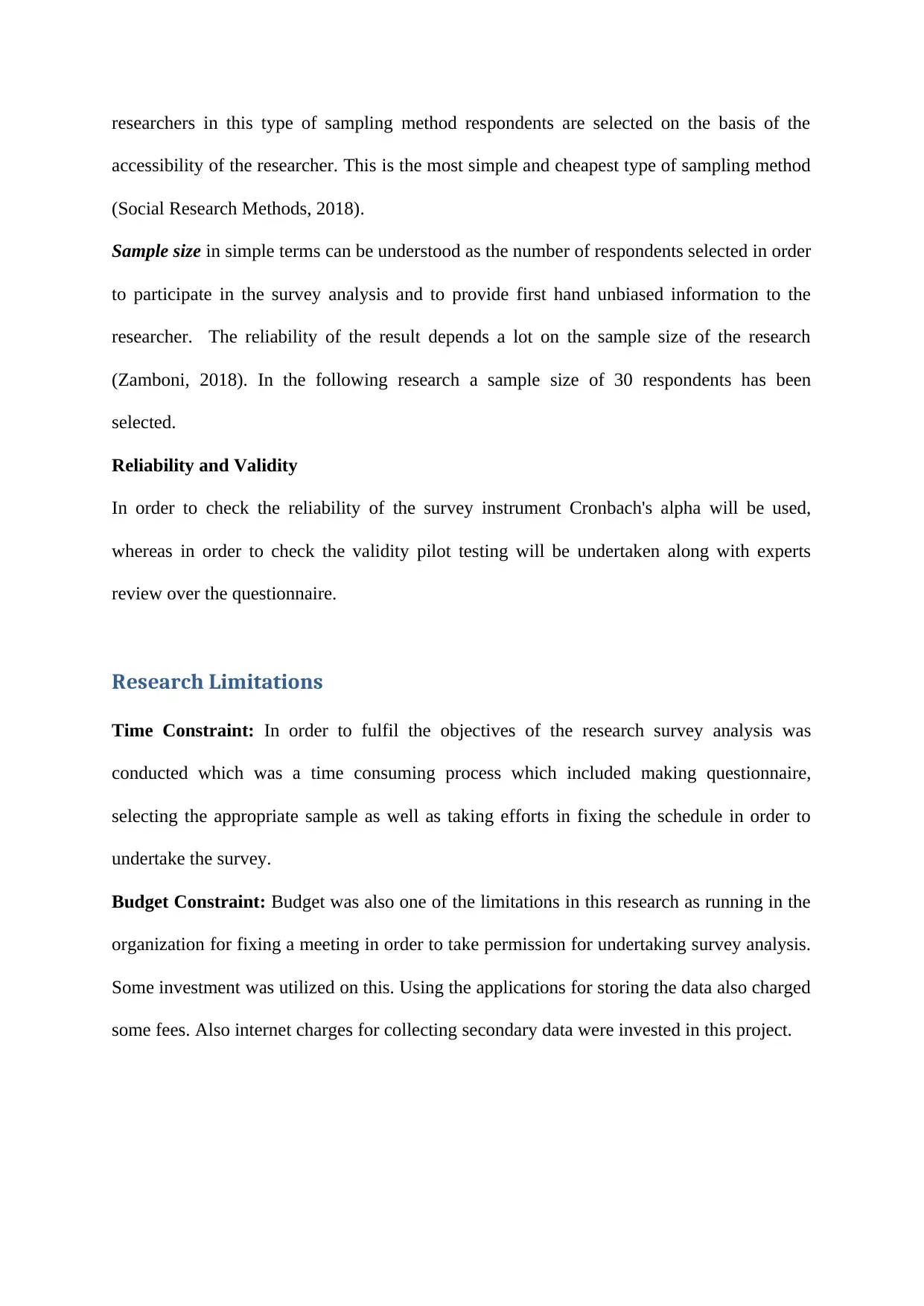
researchers in this type of sampling method respondents are selected on the basis of the
accessibility of the researcher. This is the most simple and cheapest type of sampling method
(Social Research Methods, 2018).
Sample size in simple terms can be understood as the number of respondents selected in order
to participate in the survey analysis and to provide first hand unbiased information to the
researcher. The reliability of the result depends a lot on the sample size of the research
(Zamboni, 2018). In the following research a sample size of 30 respondents has been
selected.
Reliability and Validity
In order to check the reliability of the survey instrument Cronbach's alpha will be used,
whereas in order to check the validity pilot testing will be undertaken along with experts
review over the questionnaire.
Research Limitations
Time Constraint: In order to fulfil the objectives of the research survey analysis was
conducted which was a time consuming process which included making questionnaire,
selecting the appropriate sample as well as taking efforts in fixing the schedule in order to
undertake the survey.
Budget Constraint: Budget was also one of the limitations in this research as running in the
organization for fixing a meeting in order to take permission for undertaking survey analysis.
Some investment was utilized on this. Using the applications for storing the data also charged
some fees. Also internet charges for collecting secondary data were invested in this project.
accessibility of the researcher. This is the most simple and cheapest type of sampling method
(Social Research Methods, 2018).
Sample size in simple terms can be understood as the number of respondents selected in order
to participate in the survey analysis and to provide first hand unbiased information to the
researcher. The reliability of the result depends a lot on the sample size of the research
(Zamboni, 2018). In the following research a sample size of 30 respondents has been
selected.
Reliability and Validity
In order to check the reliability of the survey instrument Cronbach's alpha will be used,
whereas in order to check the validity pilot testing will be undertaken along with experts
review over the questionnaire.
Research Limitations
Time Constraint: In order to fulfil the objectives of the research survey analysis was
conducted which was a time consuming process which included making questionnaire,
selecting the appropriate sample as well as taking efforts in fixing the schedule in order to
undertake the survey.
Budget Constraint: Budget was also one of the limitations in this research as running in the
organization for fixing a meeting in order to take permission for undertaking survey analysis.
Some investment was utilized on this. Using the applications for storing the data also charged
some fees. Also internet charges for collecting secondary data were invested in this project.
Paraphrase This Document
Need a fresh take? Get an instant paraphrase of this document with our AI Paraphraser
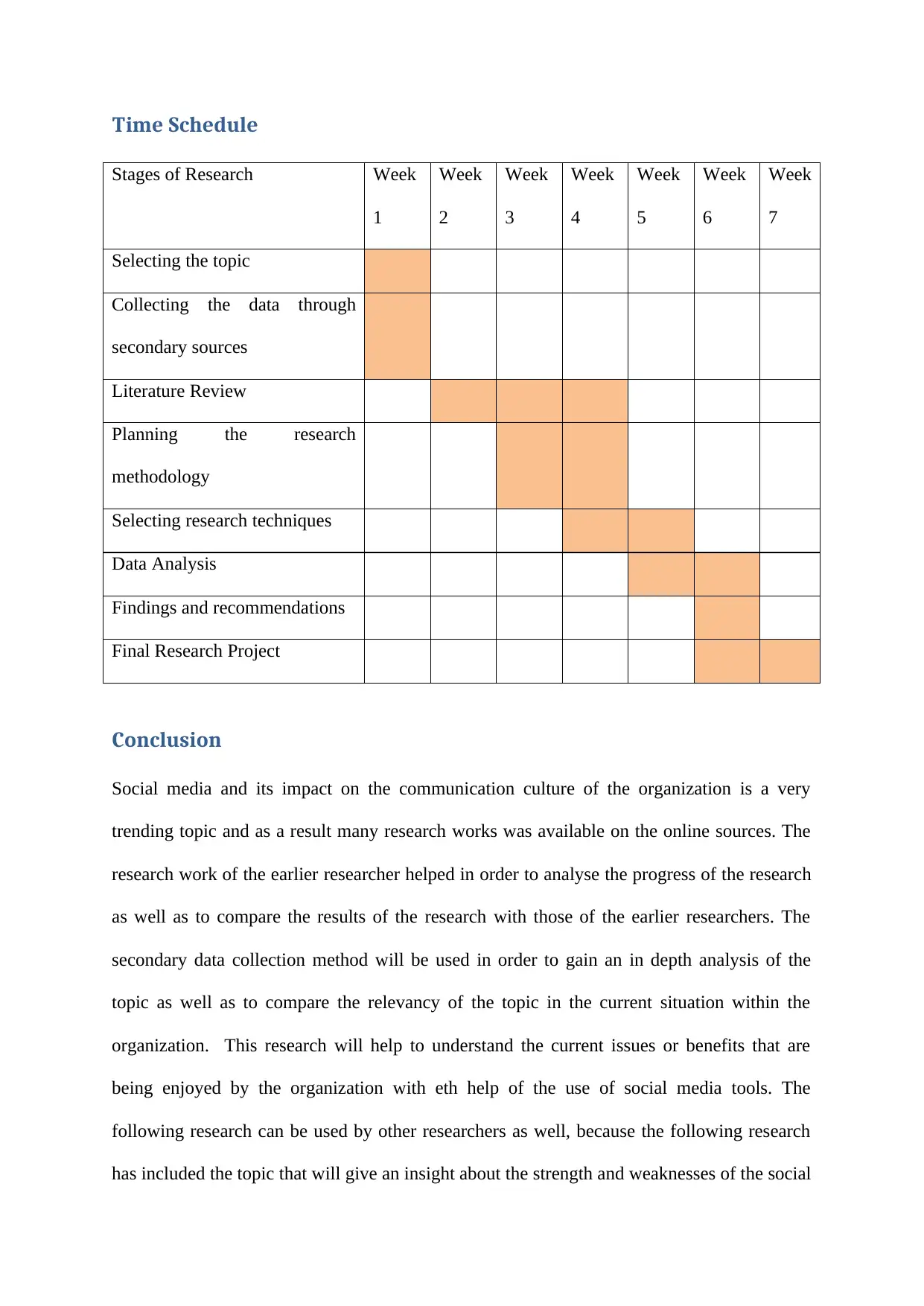
Time Schedule
Stages of Research Week
1
Week
2
Week
3
Week
4
Week
5
Week
6
Week
7
Selecting the topic
Collecting the data through
secondary sources
Literature Review
Planning the research
methodology
Selecting research techniques
Data Analysis
Findings and recommendations
Final Research Project
Conclusion
Social media and its impact on the communication culture of the organization is a very
trending topic and as a result many research works was available on the online sources. The
research work of the earlier researcher helped in order to analyse the progress of the research
as well as to compare the results of the research with those of the earlier researchers. The
secondary data collection method will be used in order to gain an in depth analysis of the
topic as well as to compare the relevancy of the topic in the current situation within the
organization. This research will help to understand the current issues or benefits that are
being enjoyed by the organization with eth help of the use of social media tools. The
following research can be used by other researchers as well, because the following research
has included the topic that will give an insight about the strength and weaknesses of the social
Stages of Research Week
1
Week
2
Week
3
Week
4
Week
5
Week
6
Week
7
Selecting the topic
Collecting the data through
secondary sources
Literature Review
Planning the research
methodology
Selecting research techniques
Data Analysis
Findings and recommendations
Final Research Project
Conclusion
Social media and its impact on the communication culture of the organization is a very
trending topic and as a result many research works was available on the online sources. The
research work of the earlier researcher helped in order to analyse the progress of the research
as well as to compare the results of the research with those of the earlier researchers. The
secondary data collection method will be used in order to gain an in depth analysis of the
topic as well as to compare the relevancy of the topic in the current situation within the
organization. This research will help to understand the current issues or benefits that are
being enjoyed by the organization with eth help of the use of social media tools. The
following research can be used by other researchers as well, because the following research
has included the topic that will give an insight about the strength and weaknesses of the social
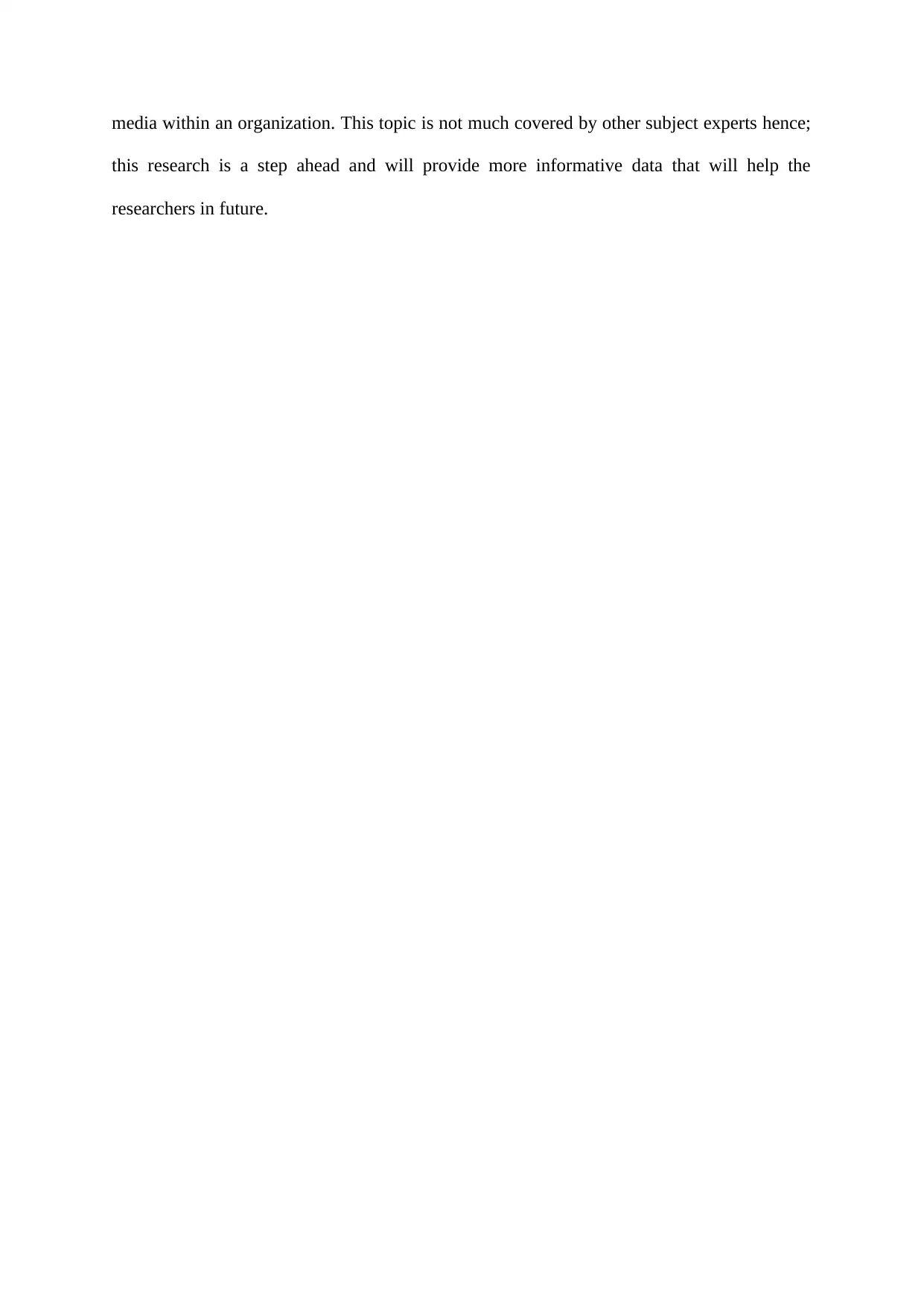
media within an organization. This topic is not much covered by other subject experts hence;
this research is a step ahead and will provide more informative data that will help the
researchers in future.
this research is a step ahead and will provide more informative data that will help the
researchers in future.
⊘ This is a preview!⊘
Do you want full access?
Subscribe today to unlock all pages.

Trusted by 1+ million students worldwide
1 out of 14
Related Documents
Your All-in-One AI-Powered Toolkit for Academic Success.
+13062052269
info@desklib.com
Available 24*7 on WhatsApp / Email
![[object Object]](/_next/static/media/star-bottom.7253800d.svg)
Unlock your academic potential
Copyright © 2020–2026 A2Z Services. All Rights Reserved. Developed and managed by ZUCOL.




